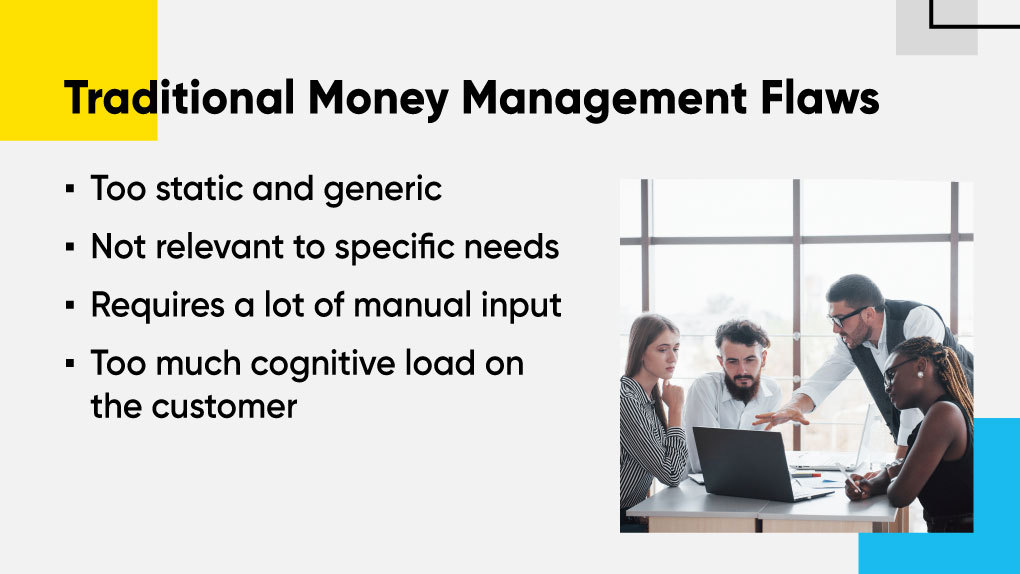April 17, 2023
Forrester Report: Banks Are Still Struggling to Monetize Their Money Management Solutions

Banks and their customers agree: Money management solutions are more important than ever. Customers want help in improving their financial well-being during a time in which inflation is on the rise and driving the soaring cost of living. Banks, meanwhile, are looking to money management solutions to help them retain their current customers, acquire new ones, and increase customer lifetime value.
Yet a recent report, conducted by Forrester Consulting on behalf of Personetics, revealed that traditional money management solutions are failing to meet expectations, both for banks and for customers.
Approximately three-quarters of financial institutions provide some form of money management solutions (73% of EMEA banks and 79% in North America), but these tools are woefully underutilized: 88% of North American banks and credit unions and 78% of European banks reported that less than half their customers are actively using their money management tools.
That’s just one of several key finding Forrester shared in their report (North American edition or European edition.) Below are a few other key takeaways.
Banks Have High Expectations for Money Management
According to the report, banks think that money management will drive significant value, with 47% of banks in the EMEA region expecting increased revenue through upsell and cross-sell opportunities, and 43% of banks in North America expecting a rise in customer engagement.
But that’s not possible without engagement. And as the aforementioned usage stats show, customers aren’t currently using the money management tools at their disposal.
Traditional Money Management Solutions Are Flawed
According to Forrester, it’s the tools, not the customers.
The report notes that “many of these solutions fail to drive behavior change and deliver tangible outcomes for customers, as they are too static and generic, not relevant to customers’ specific needs and unpredictable financial lives, still require a lot of manual input, and place too much cognitive load on the customer.”
3 Reasons Why Banks Haven’t Delivered on Traditional Money Management and PFM
1. They don’t understand the urgency
Customer demands have skyrocketed. They want a forward-looking, proactive approach to money management that goes beyond merely passively reflecting customers’ previous transactions. They are looking for either active guidance, such as a prompt that lets them know how much they can save per month, or even an automated system, in which they consent to the bank automatically moving a certain amount into their savings account on a regular basis.
This is beyond what most current money management solutions can offer. Only 59% of North America banks and 56% of EMEA banks can provide sufficient personalized financial insights based on customers’ financial data, and a similar percentage are able to use digital technologies to proactively alert customers regarding their financial goals.
2. They lack a clear business case for money management
The fact that – according to Forrester – 42% of North American banks and 40% of EMEA banks say they lack a business case for money management only compounds the problem. Without a clear business case, it’s impossible for banks to establish the right strategy for money management adoption.
It’s easy to understand what lies behind this. Many banks have an outdated view of money management based on traditional tools, like Personal Financial Management (PFM) solutions, that have no business impact and consequently see very low usage rates.
Yet today’s advanced money management solutions, in contrast, do deliver a clear business impact. These tools actually function as a business and sales channel, not purely as a customer service channel, as many banks persist in thinking of them.
3. They haven’t invested the right tech
If banks are using money management solutions with limited capabilities, they’ve likely made a mistake in their technology investment. It’s no wonder then, that 41% of banks told Forrester they struggle to select or prioritize the right tech stack.
Most still use an outdated first-generation solution that is not able to support the necessary money management capabilities. As a result, banks don’t have analytics models to access and analyze financial data to enable them to create timely, contextual content. And they haven’t linked external data sources – for example through Open Banking – to better understand the entirety of customer financial behavior. Advanced money management solutions can deliver all of this.
Many banks also lack a suitable third-party partner, and several are still trying to build in-house. In the last 15 years, a few leading global banks have been trying to develop money management propositions by themselves, and each has failed. According to Forrester’s research, 52% of North American and 45% of EMEA banks cite misalignment over build vs. buy as their top impediment.
How banks can succeed with advanced money management
After listing the reasons why banks don’t have money management solutions that meet expectations, Forrester than lays out a path to successful money management implementation, based on three pillars: strategy, metrics, and vendor assessment scorecard.
- Strategy
Banks need to increase trust and engagement through the digital channel of money management tools in order to become a trusted financial coach and guide. With this foundation, it’s then possible to offer product-based advice at the right time and in the right channel. - Metrics
Banks must shift from tracking customer satisfaction metrics to tracking sales metrics. The KPIs for money management should be usage numbers, engagement metrics, sales metrics for each product, conversion rates, and the like. - Vendor scorecard
Banks should develop a vendor scorecard to search for partners that can:
- deliver fast time-to-value, not just time-to-market;
- provide a complete platform that is agile, scalable, and delivers ROI;
- enable innovation, not just point solutions.
Advanced Money Management solutions should be a top priority for banks
The need for advanced money management capabilities is urgent. Without them, banks are losing customers and missing out on revenue. However, until bank leadership understands money management’s vital importance, they won’t be able to set the right strategy, track the right metrics, or establish the right vendor scorecard to develop the money management tools they need to reach their business goals.
Learn more by downloading the full Forrester report for your region:
- Spotlight on Europe: Banks Need to Nurture Customers’ Financial Well-Being
- Spotlight on North America: Banks and Credit Unions Need to Promote Customers’ Financial Well-Being
Interested in seeing what advanced money management looks like in action? Contact Personetics
Want To See How Cognitive Banking and AI Can Transform Customer Engagement?
Request a Demo Now
Related Posts

Survey: What Banking Customers Demand Now in the Cost-of-Living Crisis

Overdraft Response as a Competitive Advantage: How to Drive Business Impact with a Proactive Customer-centric Approach

Banks Have Digital Engagement All Wrong. It’s Time for A New Model

Dorel Blitz
VP Strategy & Business Development
Dorel Blitz brings over 13 years of experience in global strategy and business development in the financial services industry. Dorel joins Personetics from KPMG, where he headed the Fintech sector at KPMG Israel and a member of the global Fintech practice. In this role, Dorel was instrumental in establishing KPMG’s collaborative relationships with global financial institutions and leading Fintech companies including Personetics. He also acted as a subject matter expert and led advisory projects involving digital transformation strategies with financial services organizations. Prior to joining KPMG, Dorel led the Innovation & Fintech practice at Bank Leumi, and earlier in his career he headed the banking & finance division at global research firm Adkit.












